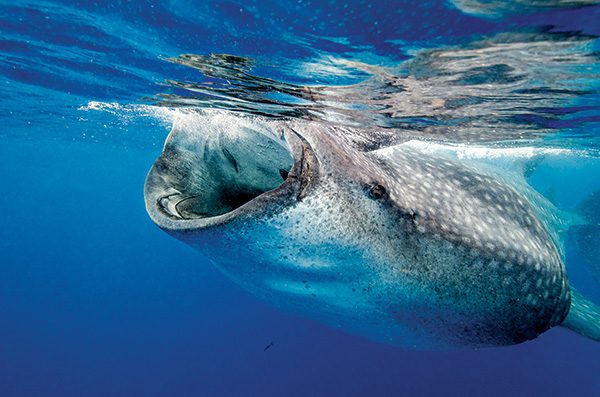Equipment: Sony DSC-RX10, 28-100mm f/1.8-4.9 lens at 28mm, Settings: 1/500 sec, f/6.3, ISO 800, Location: Scotland, Photo By Karen Straus
Whale sharks are easy. Basking sharks are hard. Whale sharks usually inhabit warm, tropical waters, while baskers prefer cooler, temperate regions.
Whale sharks are predictable: If you note the direction in which they are swimming and head there with your camera, they will likely continue in a straight line right toward you. You can take your shot and get out of the way. In contrast, basking sharks zig and zag unpredictably.
Both animals are plankton feeders, with gigantic mouths and many rows of tiny teeth. Basking sharks are invariably found in green waters, where visibility is so fuzzy it’s nearly impossible to see their entire 20- to 30-foot (6- to 9-meter) length. The same is often true for whale sharks, but in some areas they feed on fish eggs in clear, blue water.
We recently returned from a basking shark expedition in Scotland. During six eight-hour days on the water, I enjoyed 17 seconds of quality time with a basking shark. I’m not complaining though — this was nature, not Disneyland. During those 17 fleeting seconds, I shot slow-motion video, which I was able to stretch to 50 seconds of good footage. Karen did better and had four usable stills.
Water temperatures were in the high 50s°F. In my drysuit I felt like a rubber ducky bobbling in a bathtub. We were in the water for only about five minutes at a time, so if I had the opportunity to do it again, I’d bring a 7 mm wetsuit instead.
I would also wish for more than 17 seconds with these difficult to photograph giants.

Equipment: Nikon D7000, 12-24mm f/4.0 lens at 22mm
Settings: 1/250 sec, f/8, ISO 400
Location: Isla Mujeres, Mexico
Photo By Eric Hanauer
© Alert Diver — Q1 2024